




FROM CROSS BORDER AND JURISDICTIONAL COMPLEXITIES TO IMPOSSIBLE TIMELINES, WE’VE BEEN THERE AND DONE THAT.
Our mission is simple: to transform a potentially complicated and timeconsuming transaction into a seamless, customized financing solution that meets your unique needs. Our decades of experience provide an unmatched level of expertise—and the ability to craft solutions for virtually any challenge—with speed and confidence. And our global footprint gives you access to on-the-ground expertise wherever you’re operating.
So, bring us your challenges. And we’ll show you the art of what’s possible.
844.436.8200 \ info@globaljetcapital.com globaljetcapital.com
PUBLISHER AND
Jayant Baranwal
DEPUTY MANAGING
Neetu Dhulia
CONSULTING & CONTRIBUTING EDITOR
Manish Kumar Jha
PRINCIPAL CORRESPONDENT
Ayushee Chaudhary
CONTRIBUTORS
India:
Air Marshal Anil Chopra (Retd)
Group Captain Joseph Noronha (Retd)
Swaati Ketkar
Europe: Alan Peaford
CHAIRMAN & MANAGING DIRECTOR
Jayant Baranwal
PLANNING & BUSINESS DEVELOPMENT
Executive Vice President: Rohit Goel
MANAGER – HR & ADMIN
Bharti Sharma
DEPUTY MANAGER – CIRCULATION
Rimpy Nischal
GROUP RESEARCH ASSOCIATE
Survi Massey
RESEARCH ASSISTANT
Sarthak Baranwal DESIGN
Holistic Directions: Jayant Baranwal
Sr. Designer: Vimlesh Kumar Yadav, Designer: Sonu S. Bisht
GROUP DIRECTOR – SALES & MARKETING
Neetu Dhulia
DIRECTOR – SALES
Rajeev Chugh
SP’S WEBSITES
Sr Web Developer: Shailendra Prakash Ashish
Web Developer: Ugrashen Vishwakarma
© SP Guide Publications, 2024
Subscription/Circulation
Annual Inland: `1,200 • Foreign: US$320
E-mail: subscribe@spguidepublications.com subscribe@sps-aviation.com
LETTER TO EDITOR editor@sps-aviation.com; expert@sps-aviation.com
For Advertising details, contact: neetu@spguidepublications.com rajeev.chugh@spguidepublications.com
SP GUIDE PUBLICATIONS PVT LTD
A-133 Arjun Nagar, (Opposite Defence Colony) New Delhi 110003, India.
Tel: +91 (11) 24644693, 24644763, 24658322
Fax: +91 (11) 24647093
E-mail: info@spguidepublications.com
Representative Office MOSCOW, RUSSIA LAGUK Co., Ltd., (Yuri Laskin) Krasnokholmskaya, Nab.
11/15, app. 132, Moscow 115172, Russia.
Tel: +7 (495) 911 2762
Fax: +7 (495) 912 1260
MEMBER / PARTNER OF

has become the first OEM to receive Starlink STC and now offers Starlink inflight Wi-Fi for G650 and G650ER, enhancing connectivity options and convenience for customers
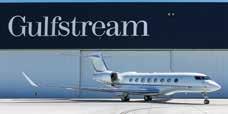

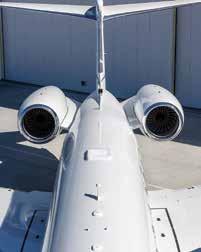


The NBAA Business Aviation Convention & Exhibition (NBAA-BACE) 2024 held in Las Vegas, showcased innovative aviation technology, including sustainable fuel solutions, electric vertical takeoff and landing (eVTOL) aircraft, and advanced avionics. The event gathered industry leaders, fostering discussions on sustainability, safety, and future growth, with a focus on business aviation’s evolving landscape and operational advancements. The event featured a variety of exhibits, educational sessions, and networking opportunities. Key themes at this year’s event included sustainability, innovation, and the future of air travel. Ayushee Chaudhary brings details of the exhibition and conferences in her show reports.
Ratan Tata’s relentless pursuit to acquire Air India, despite numerous obstacles, underscored his deep-rooted commitment to restoring the airline’s legacy under the Tata banner. His journey is a testament to visionary leadership and a drive to revolutionise industries. His strides towards transformation will always be remembered. As our tribute, in this edition, SP’s Aviation delves into Tata’s influence, his remarkable milestones, his legacy and his lasting impact on Indian aviation.
As Tata brought about shifts in Indian aviation decades back, the sector is undergoing significant shifts across various fronts again now. For instance, the recent launch of India’s Seaplane Operations Guidelines under the UDAN scheme that simplifies the certification process for non-scheduled entities, eliminating the need for water drome licenses and easing compliance. This move not only enhances regional connectivity but also unlocks new avenues for economic growth. In this issue, Ayushee Chaudhary examines how these guidelines, along with UDAN 5.4, mark a progressive step toward sustainable, innovative, and job-creating regional aviation. The future looks bright for air taxis too in India as the launch of air taxi services by 2026 seems to be on track, connecting high-density routes, with the DGCA unveiling the regulatory framework for ‘Vertiports’ to facilitate their operation. Air Vice Marshal
The NBAA Business Aviation Convention & Exhibition (NBAABACE) 2024 was a major event for the business aviation industry. It brought together industry leaders, owners, operators, government officials, manufacturers, and others to showcase the latest advancements in aviation technology, discuss industry trends, and network.
Sanjay Bhatnagar (Retd) discusses this regulatory groundwork and the paradigm shift UAM represents for urban transport. With collaboration, safety, sustainability, and an adaptive regulatory approach, UAM holds the potential to redefine intracity travel. Further, Rohit Goel reflects on India’s burgeoning private aviation sector, marked by Ambani’s acquisition of BBJ and how this acquisition speaks to the strategic importance of private aviation for India’s wealthiest individuals.
Moving from national to global business aviation front, in our cover story, the edition highlights Gulfstream’s latest milestone: FAA approval to install Starlink Internet on G650 and G650ER aircraft. This upgrade enables video calls, cloud applications, and data transfer in-flight, a leap in connectivity for the business aviation sector. Ayushee Chaudhary’s reports provides insights into Gulfstream’s forward-thinking approach to technology, as well as the impact of major global events, such as the Olympics, on business aviation. Data from WingX Advance shows the Olympics drive significant movement across regions, underlining the strong economic and tourism benefits that such events bring to host countries.
All this and more in this issue of SP’s Aviation. Welcome aboard and we wish you many happy landings!

JAYANT BARANWAL PUBLISHER & EDITOR-IN-CHIEF


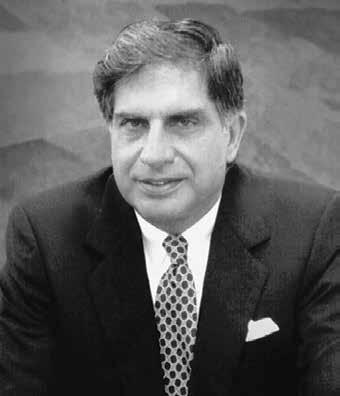
“It is with a profound sense of loss that we bid farewell to Ratan Naval Tata, a truly uncommon leader whose immeasurable contributions have shaped not only the Tata Group but also the very fabric of our nation,” N. Chandrasekaran’s statement confirmed the news, that hit millions of Indias like a ton of bricks. The nation stood still in tribute to a leader, industrialist, and philanthropist whose legacy would forever be etched in the hearts of millions. People spoke about him, remembered their times with him with smiles and tears together. Very few people in this world have this profound power that leaves anyone and everyone, remotely knowing him with a sense of deep loss and despair.
Last few days, we have seen and everything about Ratan Tata, the more we read, the more we are mesmerised and intrigued by his life, his principles and his good deeds. Recalling one such incidence in his life, Ratan Tata was facing a steady stream of questions from students in Havard Business School when one of the students asked him, “Sir, it’s a simple question, what excites you the most?” Ratan Tata took a second, and in his usual jovial manner replied, “How can I say that in public!” leaving the students in splits of laughter. Most of us know the answer to the above question, the one thing that excited him the most was ‘flying.’
Ratan Tata’s determination to acquire Air India, despite numerous setbacks and opposition, showed his unwavering commitment to reviving the airline’s legacy under the Tata name
Interestingly Ratan Tata was one of the few civilians to experience flying two of the world’s most advanced fighter jets – the F-16 and F-18 fighter jet. The year was 2007, at the Aero India show, a 69-year-old Ratan Tata, excited like a kid took hold of the control stick in the fighter’s cockpit. He fulfilled his longheld dream in that half-hour ride. Ratan Tata, who held licenses to fly both jets and helicopters flew a Lockheed Martin F-16 Jet for half-hour. Soaring through clear skies and reaching altitudes as low as 500 feet, he described his experience as nothing short of ‘exhilarating.’ At Aero India 2011, Ratan Tata took to skies once again - this time on a Boeing F-18 Super Hornet, larger and more powerful than the F-16. “It was a terrific, terrific ride. I really enjoyed today’s flight,” he said while speaking to media later.
Ratan Tata passion for aviation is well known. But it was not just his passion that made him special to aviation, he turned his passion into his dream and made sure he fulfilled it. Ratan Tata, in his quest to take Air India back under his fold, failed, failed and failed yet again. But he kept trying until he brought home his beloved ‘Air India.’
JRD Tata established Tata Airlines on October 15, 1932. JRD Tata, father of aviation in India, flew India’s first commercial flight a single-engine de Havilland Puss Moth, from Karachi to Mumbai, paving the path for civil aviation in India.





MANY EXPERTS ADVISED RATAN TATA AGAINST ACQUIRING THE LOSS-MAKING AIR INDIA, BUT RATAN TATA WAS FIRM ON HIS DECISION AND AFTER A LONG BIDDING PROCESS, THE TATA GROUP ACQUIRED AIR INDIA, MARKING THE AIRLINE’S RETURN TO ITS FOUNDERS
Post independence Tata Airlines was nationalised in 1953 and renamed as Air India. During the government tenure Air India lost its inaugural charm and charisma. The airline accumulated debt worth `50,000 crores. This was further complicated by disruptions caused by unions. All this and much more led to slow bleeding of Air India. This downfall of Air India, deeply disturbed Ratan Tata who vowed to bring back Air India, and took it up as a challenge.
“JRD Tata would have been overjoyed if he was in our midst today,” said an emotional Ratan Tata after acquiring the government-owned Air India on October 8, 2021 for a whooping `18,000 crore. Anyone with a little knowledge of finance and aviation can clearly see, this was a loss-making deal. Ratan Tata could have simply built and started a new airline, a new legacy – but he chose to bring back his dream. The dream nurtured and cherished by JRD and breaking all barriers he finally did. Air India’s ‘ghar wapsi’ to the Tata’s was one of his biggest dreams coming true.

But this journey of Air India’s ‘ghar wapsi’ was not an easy one. It was full of hurdles, oppositions and failures. Ever since taking the spot at Tata Sons as Chairman in 1991, Ratan Tata made many attempts to venture into the aviation sector only to face disappointment every time.

In 1994, the aviation sector in India was opened up for privatisation and Ratan Tata made his first move acquiring Air India. The Tatas along with Singapore Airlines wanted to establish a joint venture carrier in India with the SIA holding 60 per cent stake, and Tata’s taking the remaining 40 per cent stake. The proposal was reportedly met with strong resistance from everyone - politicians, bureaucrats as well as airlines.
In 1996, Ratan Tata made a renewed attempts with various assurances like switching the proposed shareholding stakes between the Tatas and Singapore Airlines to pacify the opposition to the deal about the concerns over a foreign airline holding majority stake in an Indian carrier. But the deal didn’t go through as the then Civil Aviation Minister opposed the deal backed by many politicians. Since then, six major private airlines entered the market and ventured into Air India’s territory. They were – Jet Airways, Air Sahara, Modiluft, Damania Airways, NEPC Airlines, and East-West Airlines.
In 2021, Ratan Tata succeeded in bringing Air India back home after the Tata Group acquired the government-owned airline for `18,000 crore, marking a historic moment of ‘ghar wapsi’ for the Maharaja

It was in 2001 the government decided against state participation in civil aviation. It tried to reduce the government’s stake by 40 per cent in the airline. Tata in partnership with Singapore Airlines was the sole bidder of the deal. But he was faced with strong opposition from the labour unions and

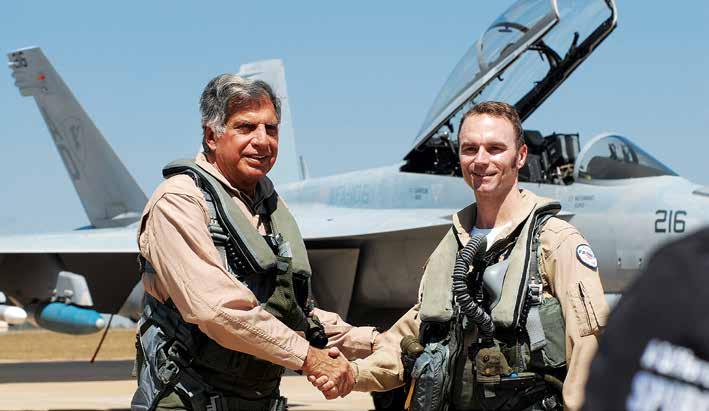
rival airlines once again putting off his dream. Thus, government’s futile attempts to privatise Air India could not be executed.
As a band-aid to this, in 2006 the UPA government merged Air India and its domestic arm Indian airlines in what appeared to be the unlikeliest of all airline mergers. The idea was to leverage the combined assets and capital to push growth. But, from 2006 the merged carrier continued to bleed losses into India’s economy. During these years, Ratan Tata made two unsuccessful bids to take over Air India in partnership with Singapore Airlines.
Then almost a decade later in 2012, the Centre relaxed FDI rules in aviation in 2012, allowing foreign airlines to own up to 49 per cent in Indian carriers. With the relaxation of FDI, Ratan Tata made a renewed attempt to enter India’s civil aviation space in partnership with Singapore Airlines and Vistara was born. On November 5, 2013, Vistara’s holding company, TATA SIA Airlines Limited, was incorporated. On January 9, 2015, Vistara started its operations with a maiden flight from Delhi to Mumbai and in a very short span of time rapidly expanded its footprint, both in terms of network and service proposition.
Around the same time, Ratan Tata ventured into an agreement with Malaysia-based Airline Group Air Asia Berhad (AAB) to launch Air Asia India (AAI). Now the Tata’s had begun to establish themselves in India’s aviation circles, with two strong JV airlines criss-crossing the nation. Thus, the launch of AirAsia India in June 2014 marked the group’s foray into the airline business a second time.
In 2017, government announced plans to disinvest its stake in Air India marking the beginning of a new chapter for the airline, as it sought potential buyers. Ratan Tata too, didn’t want to leave his unfinished ambition of bringing Air India back home
to the Tatas. The once opulent and majestic Maharaja of Air India had become dry, sultry and fore lone under the government ambit. It was clear than unless a private player took care of the maharaja, it was to perish and soon!
In 2020, Tata Group submitted a bid to acquire Air India, including its low-cost subsidiary, Air India Express. The team under Ratan Tata pulled braced themselves for impact as they ventured for the impossible deal. Many experts must have advised Ratan Tata against acquiring the loss-making Air India, but Ratan Tata was firm on his decision. After a long bidding process, the Tata Group won the bid to acquire Air India, marking the airline’s return to its founders. The government sold its 100 per cent stake in Air India to the Tatas for `18,000 crore.
Finally in 2022, after living for almost 69-years under government ambit, Air India and Air India Express returned back to Tata-fold. Ratan Tata could have easily set up a new airline instead of acquiring debt-ridden Air India, but his dreams took priority over practical approach and Air India was saved.
After the acquisition and emotional Ratan Tata tweeted, “On an emotional note, Air India, under the leadership of JRD Tata had, at one time, gained the reputation of being one of the most prestigious airlines in the world. Tatas will have the opportunity of regaining the image and reputation it enjoyed in earlier years. JRD Tata would have been overjoyed if he was in our midst today.” the statement tweeted by Tata read. There after the Tata group announced plans to invest significantly in modernising the fleet and enhancing its service quality to make it into a world-class airline and restore it to its former glory.


In November 2022 AirAsia India was fully acquired by the Tata Group as they took over the remaining 16.33 per cent stake




in AirAsia India from AirAsia Berhad, making it a fully-owned subsidiary. Soon after the plans to merge AirAsia India with Air India Express were set in motion to streamline operations
It is a little-known fact that Ratan Tata also wanted to venture into business jets and even held two strategic meetings with Captain G.R. Gopinath (Founder of Air Deccan). However, the deal was not authorised by Cyrus Mistry (2013) and had to be called off. Cyrus Mistry took over as the successor of Ratan Tata for a short while in 2013.
Ratan Tata’s vision for Aviation was not limited to Commercial and Business Aviation. He also felt the need for having a robust indigenous Military Aviation ecosystem in India. Since early 2000s, the Tatas entered into various ventures with major global defence players with an aim to become a part of their global supply chain and to bring those capabilities to India.

In October 2022, he praised the establishment of the TataAirbus joint venture for the production of C295 aircraft in India as the realisation of his decade-old vision of establishing a private aircraft manufacturing facility in India.
Tata Advanced Systems Limited (TASL), a subsidiary of Tata Sons and Lockheed Martin established a JV in 2010 - Tata Lockheed Martin Aerostructures Ltd (TLMAL), which serves as the global sole source of the C-130J Super Hercules military transport’s empennage assemblies that are used in all new aircraft produced in the US. To date, the company has manufactured over 220 empennages.
TASL entered into a joint venture with the US’ Sikorsky Aircraft Corporation to manufacture components of the Sikorsky S-92 helicopter in India for both the domestic civil and military markets. The first S-92 cabin was reportedly delivered in November 2010.
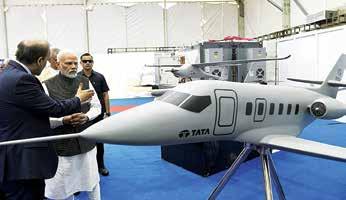
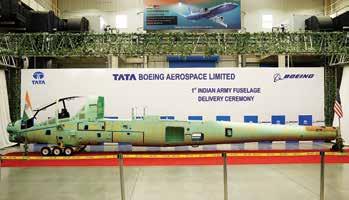
By October 2013, the S-92 helicopter cabin production in India had become 100 per cent indigenous. By then the India operation was assembling cabins along with producing all parts with over 5,000 associated precision components needed for the assembly, before shipping the cabins to the US for aircraft completion.
In April 2018, Tata Sons consolidated its various businesses across the aerospace and defence sectors into a single entity –Tata Aerospace & Defence (Tata A&D) with the sole intention of targeting emerging opportunities, enhance its competitiveness in global markets, and support the government’s “Make in India” initiative.
Then again in 2018, Tata Boeing Aerospace Limited (TBAL), a joint venture between Boeing and TASL, inaugurated a facility in Hyderabad that serves as an exclusive global manufacturer of AH-64 Apache attack helicopter fuselages, supplied to Boeing’s global clientele.
In January 2024, Airbus Helicopters announced its partnership with the Tata Group to set up a final assembly line for H125 helicopters in India. This facility will produce helicopters for both the Indian market and export to neighbouring countries.
Although the man, Ratan Tata left the mortal world behind, he left a long-long legacy behind. A legacy for India and every Indian by creating numerous employment opportunities, leading towards betterment of his motherland every step along the way! Thousands of people, young and old alike, who knew him or didn’t know him personally have mourned his death, that left a huge void in the country’s heart. May you have a smooth journey ahead Rata Tata – Rest in Peace! SP
— By Swaati Ketkar



As India prepares for the launch of air taxi services in 2026, with plans to connect high-traffic areas, Directorate General of Civil Aviation (DGCA) has revealed the regulatory framework for ‘Vertiports,’ paving the way for air taxis to become operational in India
By AIR VICE MARSHAL SANJAY BHATNAGAR (RETD)
Launch of air taxi service in India is being deliberated in various aviation circles for more than three years. We all have been talking about flying cars taking us over congested traffic in a safe manner, it no longer is science fiction. In India, recently the issue has generated lots of interest amongst common citizens after the Directorate General of Civil Aviation (DGCA) last month revealed the regulatory framework for ‘Vertiports’, paving the way for air taxis to become operational in
India. Prior to that the DGCA had issued airworthiness criteria for type certification of vertical take-off and landing capable aircraft (VCA).
Vertiports will be used by passengers to board and alight from air taxis, battery charging and parking these eVTOLs. As the acronym suggests, an electric vertical take-off and landing aircraft uses electric power to hover, take off and land vertically.
On September 12, 2024, Prime Minister Narendra Modi announced to the nation, “The day is not far when travel by air taxi will be a reality.” He chose to announce this while addressing the second Asia Pacific Civil Aviation Ministers Conference on Civil Aviation, being hosted in collaboration with the UN’s International Civil Aviation Organization (ICAO), attended by over 300 representatives from 29 countries.
In India, launch of air taxi services is being planned in 2026. Agencies involved are claiming to be able to do the 30 km trip between Gurugram to Noida in less than seven minutes as compared to 90 minutes by road.
The issue of air taxi falls under the ambit of Urban Air Mobility (UAM). It refers to a system of air transportation that utilises electric vertical takeoff and landing (eVTOL) aircraft to transport passengers and cargo within urban and suburban areas. The main goal of UAM is to provide a fast, efficient and sustainable alternative to ground-based transportation, thereby reducing traffic congestion and travel times.
UAM is the use of small, highly automated aircraft to carry passengers or cargo at lower altitudes in urban and suburban areas, which have been developed in response to traffic congestion. It usually refers to existing and emerging technologies such as traditional helicopters, vertical-takeoff and landing aircraft (VTOL), electrically propelled vertical-takeoff and landing aircraft (eVTOL), and unmanned aerial vehicles (UAVs).
UAM refers to the concept of ondemand flights and automated air transportation services, typically provided by highly automated aircraft that operate within urban and suburban environments.
The main goal of UAM is to provide a fast, efficient, and sustainable alternative to ground-based transportation, reduce travel time by avoiding traffic on the roads. Passenger acceptance of the concept and value of time convenience are the driving factors for UAM. The stakeholders need to critically examine the safety aspects, social agreements, aircraft safety aspects, piloted or automatic flights without pilots and host of other issues before commencing the UAM services.
operations in dense urban environments. These systems must integrate with existing air traffic control and account for factors such as weather, obstacles and collision avoidance from UAVs other aircraft. Traffic route management needs to be adaptable to flexible routing and schedules, hence there is an inescapable requirement for intelligent routing algorithms, catering for weather, turbulence hot spots and numerous other factors. A key trend shaping the UAM market growth is the integration of advanced autonomous systems and AI in UAM vehicles. The incorporation of AI and machine learning in UAM aircraft enhances their ability to navigate complex urban environments, make real-time decisions, and optimise flight paths.
• Public acceptance through trust building is highly crucial for it to be appealing to the passengers. While flying over populated areas, UAM has to deal with issues of rotor sound menace, privacy while flying over property in urban areas and of course issue of costing and ticketing.
• UAM can provide a range of services, including passenger transportation (air taxis), emergency medical transport, and delivery of goods and supplies.
Prime Minister Narendra Modi announced that air taxi travel in India is not far off, highlighting the government’s commitment to this innovation at the second Asia Pacific Civil Aviation Ministers Conference
• UAM must seamlessly integrate with legacy existing air traffic and other modes of transportation, such as public transit and ride-sharing services, to provide a comprehensive and efficient mobility solution.
UAM has the potential to revolutionise urban transportation and improve quality of life in cities around the world. Implementing UAM systems offers numerous benefits for cities and its residents. By providing a fast and efficient alternative to ground-based transportation, UAM can significantly reduce travel times and accessibility alleviate traffic congestion. This not only saves time for individuals but also has the potential to boost economic productivity by reducing the hours lost due to gridlock. Moreover, UAM can improve to underserved areas.
UAM involve a complicated ecosystem, wherein its various subsets are required to synergise to produce best effect. Its components include:
• eVTOL aircraft are electric-powered aircraft that can take off and land vertically, eliminating the need for longer operating surfaces. They are designed to be quiet, efficient, safe and environmentally friendly.
• Vertiports are dedicated takeoff and landing facilities for eVTOL aircraft, often located on rooftops or other urban spaces of critically specified dimensions and clearances. Also needed are battery charging stations at the Vertiports itself.
• Air traffic management systems. UAM requires advanced air traffic management systems to ensure safe and efficient
Several nations are embracing this new technology. The process of design and development is rather complicated and involves rigorous innovation cycles. Companies abroad have flown thousands of miles before applying for certification for prototype, prior to considering operations in cities. Regulatory framework, too, is evolving globally across all regulatory bodies to pave the way for air taxi operations in various cities.
The Middle East has emerged as the leading location globally for the initial growth of the UAM industry. Dubai passed regulations in 2020 to facilitate flying taxis and drone deliveries. A US based and a Chinese company have signed separate MoUs for developing the capabilities and commencing operations in Dubai. Saudi Arabia is in advanced stage of exploring similar capabilities with a US based company. In Australia, companies are applying for CASA certification on the lines of FAA. Similar is the case in Japan, where certification from Japan Civil Aviation Bureau is awaited.
In the US, Department of Defense, under a US Air Force project has been exploring the eVTOL revolution, especially for
carriage of equipment. EHang, a Chinese private company is already flying a two-seater flying vehicle without pilots. Companies are exploring quadcopter designs as well as use of coaxial rotors. Also, new battery designs and technology are being explored.
FAA’s regulations are yet to come up with guidelines for pilotless flights as it seems to be following a gradual cautionary approach of first proving the concept of piloted flight and once accepted by the environment, a pilotless version could be considered at a later date.
Enterprises and Archer Aviation have entered into a close to $1 billion deal to bring 200 all-electric air taxis to India by 2026
Now, India is preparing its own infrastructure with DGCA setting up formal guidelines for operations, infrastructure, parking, battery charging, landing, and emergency protocols at Vertiports. The aim is to develop UAM infrastructure around existing helicopter routes, helipads, and Air Traffic Control (ATC) services, eventually expanding into specially designated Vertiports.
DGCA while developing the guidance advisory for UAM has taken global practices into consideration through extensive
battery pack recharging time of approximately 30-40 minutes.
Presently, the aircraft ‘Midnight’ is in the final stages of securing approvals from the Federal Aviation Administration (FAA) in the US, thereafter it will undertake trials in India to be able to launch the service commercially in 2026.
In India, Air taxis are planned to be launched in high-traffic regions like Delhi NCR and Mumbai, at limited destinations, essentially extending significant relief from road congestion. These flights will be piloted by a single pilot. Presently, by 2026, Air Taxis between Gurugram, Noida, Greater Noida and Faridabad are being considered. Other metros like Bengaluru, Hyderabad and Chennai could be next for UAM solutions.
According to forecast compiled by Global UAM Research team, over next five years, currently 1,044 vertiports are being planned for development. According to Forbes 2023 report, global UAM market is likely to grow at a CAGR of 12.1 per cent

consultations with broad section of stakeholders. This Advisory Circular is issued under the provisions of CAR-21 issued under Rule 133A of The Aircraft Rules. This airworthiness certification requirements applies to eVTOL capable aircraft with pilot onboard with a maximum take-off weight up to 5,700 kg. The circular include, basic infrastructure requirement specifications; physical attributes for vertiports; guidelines to ensure air taxis’ safe and unobstructed take off and landing; battery charging requirements and emergency response planning.
InterGlobe Enterprises, the parent company of IndiGo and Archer Aviation of the US have entered into an agreement to operate an all-electric air taxi service in India by 2026. The understanding has been developed to purchase 200 aircraft called, ‘Midnight’ under a close to $1 billion deal. These are piloted four-seater eVTOL aircraft with a range of 100 miles and
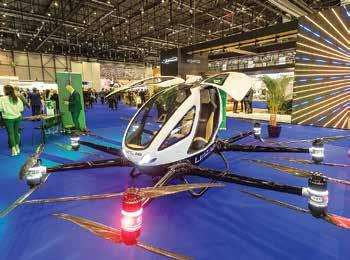
between 2030-35 and reach a value of USD 41.5 by 2035.
A US based Electric air taxi company, in collaboration with a German subsidiary, has recently flown an eVTOL hydrogenelectric air taxi on a 500 miles plus trip, thereby opening exciting possibilities of bringing air taxi services around cities.
Back home, we have a homegrown ‘The ePlane Company’, a startup incubated at IIT Chennai that is developing a certifiable prototype of a flying taxi by March 2025.
UAM represents a paradigm shift in urban transportation, offering immense promise alongside certain challenges. By navigating these challenges collaboratively, embracing innovation and prioritising safety and sustainability, through adaptive regulatory approach and informed policy decisions, the aviation industry can unlock the full potential of UAM and revolutionise the way we move within our cities. SP





According to data from WingX Advance, mega events like the Olympics, significantly impact business aviation, driving increased movements across several regions
By AYUSHEE CHAUDHARY
What can a major global event really do? Beyond the buzz of headlines, photo ops, and the palpable excitement of athletes, fans, and celebrities flocking to the host city, these events are also a significant driver of global travel, particularly for highnet-worth individuals (HNWIs). The Olympics, one of the world’s largest and most prestigious events, is a prime example of how such spectacles create a ripple effect across various industries.
From tourism to media, the impact on the host nation’s economy is unmistakable. Further, it’s noteworthy how global events like the Olympics fuel the business aviation sector.
HNWIs, dignitaries, and corporate executives travel in private jets, seeking flexibility, convenience, time savings and the ability to arrive fresh and ready for business or leisure. The latest edition of the Olympics was no exception, with private jet activity surging
to meet the demands of the high-profile attendees. According to data from WingX Advance, an aviation industry intelligence company, the Olympics significantly impacted business aviation, driving increased movements across several regions.
The opening ceremony and key sporting events became hotspots for private jet traffic, particularly from the United States (US), with many flights passing through the United Kingdom (UK). This Olympic surge helped the business aviation market recover from what had been a sluggish first half of 2024. WingX Advance reported that year-to-date trends, which had been flat, started to climb back, marking a turning point for the sector.
Europe emerged as a bright spot for the business jet market this summer. The Olympics not only drew record numbers of private jets to France, where many events were held, but also brought an influx of sports fans into the UK. While demand in the US slowed slightly in early August after a strong July, Europe’s leisure market remained a key driver of growth, with high-end tourists fueling private jet movements across the continent.
In line with the Olympics’ impact, Germany, host of the UEFA Euro 2024 that were held prior to the Olympics also saw a nine per cent increase in bizjet activity during the Euro qualifiers in Week 25, despite a two per cent yearon-year decline.
In contrast, business jet activity in key destinations across Asia and Africa remained subdued, with a weaker August performance mirroring the US slowdown. However, the overall global trend remained stable, majorly due to the Olympics’ ability to attract global elites. In late July, global business jet activity had reached 74,198 flights during the Olympics, matching the same period in 2023. Charter and fractional ownership flights grew by two per cent, totaling 39,722 sectors flown in the last month of July. WIngX noted that nearly 25 per cent of Week 30’s bizjet flights were managed through aircraft management programs, indicating continued demand for private travel services.
the US increased by three per cent year-over-year, driven by key states like Florida, California, and Texas, all of which saw growth in departures. Conversely, Colorado’s bizjet activity dropped by two per cent, while New York experienced robust growth.
The Paris Olympics boosted trans-Atlantic flights, particularly between New York and Paris. In Week 30, there were 20 flights from New York to Paris, compared to just three the previous year. Vista Jet and NetJets were leading operators in this surge of high-end travel during the Games.
In Week 32, among the top 10 US states, only New York and Massachusetts showed year-on-year growth. Westchester County saw a 10 per cent increase in flights, with NetJets as the leading operator. Leisure destinations like Nantucket and East Hampton grew by 28 per cent and 125 per cent, respectively.
In August, turboprops accounted for 26 per cent of bizjet departures in L.A., with very light jets making up just 1 per cent. The Van Nuys–John Wayne route was the most active, with 46 flights recorded. As Los Angeles prepares for the 2028 Olympics, eVTOL aircraft are being explored as a solution to traffic congestion.
The opening ceremony and key sporting events became hotspots for private jet traffic, particularly from the United States (US), with many flights passing through the United Kingdom (UK)
When August began, business jet activity held strong with 70,212 sectors flown, just one per cent below the previous year. While this was lower than the Week 26 peak of 76,524 flights, the four-week trend remained positive at 0.2 per cent above 2023 levels. By mid-August, global bizjet movements saw a slight dip, with 69,409 sectors flown, down 1 per cent yearover-year. The four-week trend stayed resilient, up by 0.3 per cent from last year. However, year-to-date, global bizjet activity (January to August 11) was down one per cent from 2023 and three per cent from 2022. Total flight hours followed a similar trend, down two per cent year-over-year.
In North America, Week 30 saw 50,871 bizjet departures, consistent with last year’s numbers. The US, the world’s busiest private jet market, recorded nearly 49,000 flights, a one per cent increase year-over-year. The US contributed 94 per cent of North America’s total bizjet movements.
In July, US bizjet activity rose by two per cent compared to 2023, with Canada seeing a seven per cent decline. Flight hours in
Cessna jets led US bizjet activity in August, with 27,500 departures, just one per cent below 2023 levels. Embraer saw a four per cent rise, while the newly certified Gulfstream G700 attracted attention. Savannah, Georgia, became a hub for the G700, with 53 active aircraft globally.
The Olympics drove a significant rise in European business jet activity, especially in France, which saw a 17 per cent increase during Week 30 compared to 2022. European bizjet traffic rose four per cent overall, with the UK up 10 per cent. On the day of the opening ceremony, France saw 382 bizjet arrivals, and Paris Le Bourget recorded a 53 per cent increase. New York was a key origin point for flights to Paris, with a 200 per cent surge in traffic.
While Olympic cities flourished, European vacation hotspots saw mixed results. Mykonos lagged pre-pandemic levels, but Olbia and Sardinia recorded their busiest July in five years. Ibiza and Mallorca saw declines in activity compared to previous years.
In Week 31, bizjet activity across Europe grew six per cent, with France leading the way at 19 per cent. As August progressed, France continued to see strong growth, with a 25 per cent increase in Week 32. Paris Le Bourget’s traffic spiked by 73 per cent on the day of the men’s 100m sprint final. Italy, Spain, and the UK also experienced robust bizjet demand, while Germany saw a four per cent decline.
France’s bizjet traffic ended strong in Week 32, up 18 per cent, with Nice Côte d’Azur becoming the busiest airport. London-Nice connections surged by 40 per cent. Ultra Long-Range jets dominated the final weekend of the Olympics, with 56 arrivals in Paris between August 9-11.
While business jet activity continued to thrive in North America and Europe, accounting for around 90 per cent of global

movements, the picture elsewhere was less optimistic. In recent weeks, bizjet departures outside these two major markets showed a marked decline, with regions such as the Middle East and Africa bearing the brunt of this downward trend.
In Week 30, bizjet activity in the Middle East dropped by 16 per cent compared to the same period in 2023. Key cities like Abu Dhabi, Dubai, and Riyadh saw significant declines in business jet movements, contributing to an overall nine per cent reduction in the region’s four-week trend compared to last year. Although Week 31 saw a modest three per cent recovery in activity, it wasn’t enough to offset the broader slowdown. The region, which typically accounts for about 25 per cent of bizjet traffic outside North America and Europe, is experiencing a lingering decline, with a seven per cent drop in bizjet flights during the previous month.
Despite this general downward trend, the United Arab Emirates (UAE) presented a brighter spot, with a noticeable increase in bizjet traffic, particularly in connections between London and Dubai. This uptick highlights the ongoing appeal of Dubai as a destination for high-net-worth travelers, even amid broader regional challenges.
Africa’s business aviation sector has been hit even harder. In Week 30, bizjet activity across the continent plummeted by 23 per cent year-on-year, with major cities like Johannesburg, Lagos, and Cape Town all recording significant declines. The four-week trend shows a nearly 20 per cent decrease in bizjet flights compared to the same period last year. As of Week 32, the situation has not improved, with bizjet departures down by 24 per cent year-on-year.
In contrast to the declines seen in the Middle East and Africa, South America has shown a slight uptick in bizjet activity. Week 30 saw a one per cent year-on-year increase in departures across the region, a small but positive sign amid broader global challenges. However, by Week 32, bizjet flights in South
America had fallen by five per cent compared to the same period last year, indicating that growth remains fragile.
Asia also saw a reduction in bizjet activity in recent weeks. Bizjet departures from the region fell by eight per cent during Week 32, adding to the overall global decline outside North America and Europe. The region’s reliance on commercial aviation and the slow recovery of international business travel in some parts of Asia may be contributing factors to this drop in bizjet movements.
While North America and Europe continue to dominate the global business aviation landscape, the rest of the world is experiencing a slowdown in bizjet activity. The Middle East, Africa, Asia, and South America have all recorded declines over the past month, with Africa seeing the steepest drop. As global economic uncertainty and geopolitical challenges persist, these regions may face continued pressure in their business aviation sectors, highlighting the uneven recovery in the post-pandemic world. However, bright spots like the UAE and modest growth in South America suggest that certain markets still hold promise for future growth.
As Europe plays host to some of the world’s most prestigious sports events, business aviation is thriving. The Olympic Games and UEFA Euro tournament have drawn an influx of high-net-worth individuals, athletes, and corporate executives, boosting bizjet traffic across key European cities. France, in particular, has benefited from this surge, with airports like Paris Le Bourget handling record numbers of business jets.
The growth in business jet activity reflects the unique demands of high-profile global events, with private aviation offering flexibility, convenience, and luxury. As the European sports calendar continues to evolve, the business aviation sector is poised to capitalise on future opportunities, further cementing its role as a critical player in the region’s transportation landscape. SP

GULFSTREAM
This certification enables G650 and G650ER owners to upgrade their in-flight connectivity directly with Gulfstream that can support video calls, cloud-based applications, and data transfers
By AYUSHEE CHAUDHARY
On October 28, 2024, Gulfstream Aerospace Corp. announced a significant advancement in passenger connectivity for its business jets. The company received the Federal Aviation Administration (FAA) supplemental type certification to install Starlink high-speed internet on its flagship G650 and G650ER aircraft. This certification enables G650 and G650ER owners to upgrade their in-flight connectivity directly with
Gulfstream, streamlining the installation process and ensuring a level of quality control customers expect from the luxury aircraft manufacturer.
“Starlink is an offering that we know is important to operators,” commented Derek Zimmerman, President of Gulfstream Customer Support. He highlighted Gulfstream’s extensive efforts to ensure a smooth integration, adding, “Our team has invested
extensive time and resources preparing for this certification, and we are well-positioned across our service network to provide a seamless installation. Having the capability to install this connectivity upgrade at our own facilities, in the hands of our trusted team of experts, is part of our ongoing commitment to our customers.”
With Starlink, Gulfstream’s G650 and G650ER passengers gain simultaneous access to robust high-speed in-flight connectivity that can support video calls, cloud-based applications, and data transfers, at impressive download speeds ranging from 40 to 220 Mbps and a low latency of under 99 milliseconds. This technology enables a seamless online experience in the air, similar to that available on the ground, meeting the connectivity demands of modern business travelers.
Celebrating this milestone, Gulfstream announced the achievement on social media with the post: “#Starlink has arrived — Gulfstream has officially received FAA supplemental type certification to install the high-speed internet service on the G650/ER.”
Furthermore, Gulfstream is actively working to extend Starlink’s connectivity upgrade across its fleet. The company is in pursuit of similar FAA certifications for a range of its models, including the G800, G700, G600, G500, G400, G280, GIV, GIV-X, GV, and GV-SP. This ambitious expansion reflects Gulfstream’s commitment to enhancing the passenger experience through cutting-edge connectivity across its entire lineup.
In May this year, Gulfstream’s G650 and G650ER models surpassed 1 million flight hours, with over 560 aircraft in service globally. Since the G650’s launch in 2012, followed by the G650ER in 2014, these models have redefined business aviation, even earning the prestigious 2014 Collier Trophy for their innovation in performance, safety, and efficiency. Together, the G650 and G650ER have set over 125 city-pair speed records, with the G650ER holding the record for the farthest and fastest business jet flight. Both aircraft feature a flexible, awardwinning interior known as the Gulfstream Cabin Experience, offering fresh air, a low cabin altitude, and 16 large windows to accommodate up to 19 passengers.
internet service, now available worldwide. Designed to keep passengers connected regardless of their location, Starlink offers download speeds between 40 and 220 Mbps, supporting a wide range of internet activities, from video calls and online gaming to VPN use and data-intensive applications. With latency under 99 milliseconds, Starlink’s performance makes it suitable for multiple passengers to engage in high-demand internet functions simultaneously—a remarkable advancement in aviation connectivity.
One of Starlink’s standout features is its global coverage, extending even to challenging environments like open oceans, high-latitude regions, and polar areas. The service provides uninterrupted connectivity throughout the flight, from taxi and takeoff to cruise and landing, thanks to regulatory approval for in-motion connectivity in numerous countries. The list of approved nations continues to expand, but Starlink’s connectivity is functional over most of the world’s airspace, including international waters, with only minimal exceptions.
Starlink’s connectivity is functional over most of the world’s airspace, including international waters, with only minimal exceptions. To support its highspeed global network, Starlink operates a constellation powered by over 9,000 optical space lasers, which transmit more than 10 petabytes of data each day.
To support its high-speed global network, Starlink operates a constellation powered by over 9,000 optical space lasers, which transmit more than 10 petabytes of data each day. These lasers allow sustained 100 Gbps links across distances as vast as 3,300 miles, forming a mesh network with a reliable 99.99 per cent uptime. This robust infrastructure ensures passengers can stay connected even on flights over remote or unpopulated areas, offering the confidence of seamless, consistent internet access.
In addition to high reliability, Starlink’s Aero Terminal hardware is built for versatility, supporting a range of aircraft from commercial airliners and business jets to supersonic models, helicopters, and VTOL (Vertical Take-Off and Landing) aircraft. The service has already been deployed successfully on more than 30,000 flights, showcasing its adaptability and durability. Starlink continues to expand its certifications and supported aircraft, anticipating even broader adoption in the aviation sector. With these advancements, Starlink Aviation is set to dramatically enhance the passenger experience, making high-quality, streaming-capable internet available to anyone, anywhere in the skies.
In 2023, Gulfstream and Honeywell introduced the Primus Epic Block 3 avionics upgrade for these models, enhancing safety with upgraded visuals, communications, and navigation tools. Performance-wise, the G650 can reach up to 7,000 nautical miles at Mach 0.85, while the G650ER extends to 7,500 nautical miles. Both can reach a top speed of Mach 0.925, a cruise altitude of 51,000 feet, and are certified by the FAA and EASA for steep-approach landings.
Starlink Aviation, developed by SpaceX, is redefining the inflight connectivity landscape with its high-speed, low-latency
Gulfstream continues to lead the charge in sustainable aviation, prioritising both environmental responsibility and customer convenience in its latest advancements. More recently on October 30, Gulfstream announced the successful completion of groundbreaking emissions testing on its G700 jet, which was powered by 100 per cent neat sustainable aviation fuel (SAF) with zero sulfur content. This advanced testing is part of a broader effort by the company to measure and reduce aviation’s environmental impact. Utilising Rolls-Royce Pearl 700 engines, the G700’s ground emissions tests assessed several fuel compositions, including a 30/70 SAF blend as well as 100
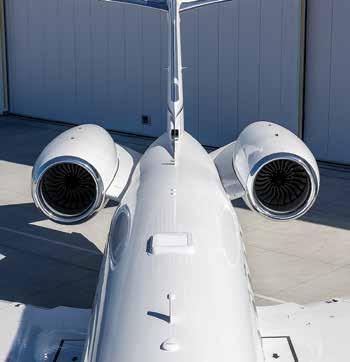
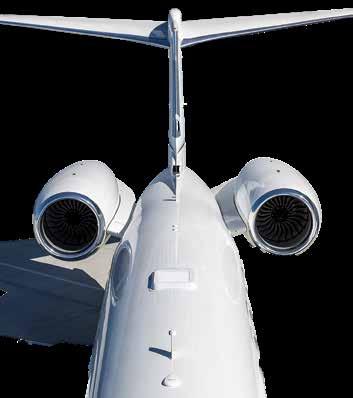
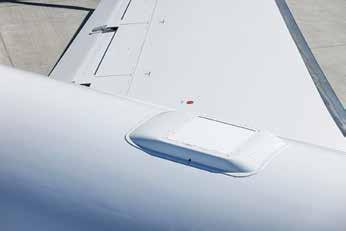
per cent neat SAF—a renewable fuel made without fossil components. Gulfstream anticipates that the insights gained from these tests will contribute to a cleaner future for business aviation, enabling the industry to move forward with more sustainable fuel options.
“Gulfstream has a rich history of innovating for sustainable aviation dating back to 2004 with the first ISO certification for our Savannah facility,” said Mark Burns, President of Gulfstream. “Our journey continues today as we work to enhance our understanding of fuel properties and their environmental characteristics to assess business aviation’s impact on the climate, chart the path forward in decreasing that impact and lead the industry in driving its sustainable aviation goals.”
This meticulous emissions testing took place at Gulfstream’s Savannah, Georgia, facility, with 100 per cent neat SAF supplied by World Energy and transported by World Fuel Services. The
Manufacturer + Airframe FAA STC Number Additional STCs
Airbus A321Neo ST09939AC EASA
Airbus A330 ST04732NY
Boeing 777-200LR/300ER ST04739NY
Bombardier Global 5000/5500 ST04612CH
Bombardier Global 6000/6500 ST04612CH EASA, TCCA, ANAC
Bombardier 7500 ST04612CH TCCA, ANAC
Bombardier Global Express/ XRS ST04612CH EASA, TCCA, ANAC
Embraer ERJ-135 ST04219NY
Embraer ERJ-145 ST04219NY
Gulfstream G350 ST04611CH AFAC
Gulfstream GIV/G450 (GIVSP*, GIV-X) ST04611CH AFAC
Gulfstream GV/G550 ST04611CH AFAC
Gulfstream G650/G650ER ST04603CH EASA
Textron Cessna Citation 560XL, XLS, XLS+ ST02804SE
Textron Beechcraft Super King Air 200/300 ST02752SE EASA, ANAC, UK-CAA
Applicable to all GIV-SP Aircraft Serial Number (ASN) >1215 and certain aircraft with ASN <1215. Please check the STC for details.
Source: www.starlink.com
Download Per Terminal Upload Per Terminal Latency
40-220 MBPS 8-25 MBPS Less than 99 MS
Source: www.starlink.com
data, which included both gaseous and particle measurements, focused on evaluating the environmental effects of SAF—especially the benefits of sulfur-free, aromatic-free 100 per cent neat SAF. Early results indicate a notable reduction in greenhouse gas emissions and minimal sulfur contamination, underscoring SAF’s promise for decreasing air pollution around airports and potentially curtailing the formation of condensation trails. To capture precise emissions data, specialised instruments provided by the FAA, NASA, Aerodyne Research, and Missouri University of Science and Technology (Missouri S&T) were used throughout the weeklong test.
By refining SAF technologies and conducting rigorous emissions tests, Gulfstream is helping to pave the way toward a cleaner, more sustainable future in aviation, setting a standard that aligns with the industry’s commitment to reducing its ecological footprint. SP

The 2024 NBAA-BACE highlighted major trends including Fractional Ownership, Business Aviation Safety and Security, Sustainability, Advanced Air Mobility (AAM), Artificial Intelligence in Business Aviation, and overall industry growth
By AYUSHEE CHAUDHARY
The NBAA’s 2024 Business Aviation Convention & Exhibition emphasised using industry giants’ lessons to drive toward a promising future. “We create jobs, provide global access, boost productivity, support relief efforts, and continu-
ously focus on efficiency and sustainability,” said NBAA’s President Ed Bolen.
The NBAA-BACE panel of top aircraft brokers reported continued demand for pre owned jets, despite a market adjustment
post-COVID. “Year-over-year, we’re seeing a balanced, healthy market,” noted jetAVIVA CEO Emily Deaton. While fleet availability rose to 6-7 per cent, Dallas Jet International’s Brad Harris emphasised it remains a seller’s market.
Shifts in buyer demographics also emerged, with younger clients favoring fractional ownership and single-seat charters due to sustainability considerations. Looking forward, Steve Varsano of The Jet Business pointed to OEMs’ own advanced products from the last decade as their main competition. Transaction times remain strained due to supply chain issues, but brokers don’t expect headlines on the economy or geopolitical events to impact jet sales significantly.
“People buy airplanes because they need them for business,” Varsano concluded. Through several of these discussions that took place during the convention, some of the major topics and trends observed at NBAA BACE included Fractional Ownership; Business Aviation Safety and Security; Sustainability; Advance Air Mobility; Artificial Intelligence in Business Aviation and the growth trends of the industry.
Despite pressures like IRS scrutiny, new fuel taxes, and heightened visibility of operator movements, demand for business aircraft remains steady, though not surging, said Brian Foley of Brian Foley Associates during a panel on fractional ownership trends at 2024 NBAABACE. “We’re holding steady at around 700 unit deliveries per year since 2012,” Foley observed, contrasting with the record 1,300 units back in 2007-2008.
One major change is in the user base: while traditional Part 91 operations have dipped, Part 135 charters are up seven per cent, and fractional ownership has soared by 56 per cent compared to pre-pandemic figures, said Ronald Epstein of Bank of America Global Research. The shift began during COVID-19, as many found fractional ownership’s lower commitment appealing, which Epstein suggested reflects a longer-term trend.


Richard Aboulafia from AeroDynamic Advisory highlighted privacy as a key driver for fractional ownership and charters, noting they offer a level of anonymity absent from direct ownership, helping executives avoid scrutiny from activists or regulators. “Anonymity is a virtue here,” he emphasised.
On a positive note, Epstein mentioned that supply constraints have instilled discipline in the industry, with nearly every jet now built having an owner lined up. While workforce shortages persist, Aboulafia argued these limitations could pave the way for a more sustainable recovery by enforcing industry discipline, ultimately creating a “good runway ahead.”
The 2024 NBAA National Safety Forum concluded with a discussion on business aviation safety, spotlighting the importance of safety management systems (SMS) and collaboration between business aircraft operators and the National Transportation
Safety Board (NTSB). During the final session at NBAA-BACE, NBAA President and CEO Ed Bolen reaffirmed the organisation’s commitment to safety, calling it a core value that guides every aspect of business aviation.
Additionally, NBAA’s Small Operator Symposium provided valuable guidance for small flight departments. Safety experts shared practical steps for improving safety in small operations, including implementing safety briefings, flight risk assessment tools, standard operating procedures, and safety audits. The NBAA’s Domestic Operations Committee also released a new resource, “Five Simple Steps to a Safer Flight Operation,” to support smaller flight departments in enhancing their safety practices.
At 2024 NBAA-BACE, a panel discussion led by Robin Riedel of McKinsey & Company explored the potential of artificial


intelligence (AI) in business aviation. Experts shared insights on how AI could enhance safety, reduce costs, and improve flexibility and responsiveness, with some applications already in use today.
Mark Groden, CEO of Skyryse, explained that AI is a broad term, encompassing both deterministic and non-deterministic systems. While deterministic AI, like integrated fly-by-wire systems, is already used for aircraft control, Groden emphasised that non-deterministic AI has greater potential in areas like maintenance and scheduling rather than in the cockpit.
Dr Yemaya Bordain, President of Daedalean AI, highlighted the future role of non-deterministic AI in aircraft, particularly for traffic identification and situational awareness. Her company’s technology is already being used in search-and-rescue operations and can detect hazards like birds before a strike occurs, effectively acting as a second set of eyes for pilots.
Jon Damush of uAvionix Corporation focused on how AI can simplify pilot operations and improve safety, citing their use of machine learning to identify potential hazards like birds or ultra-light aircraft in low-altitude, non-controlled airspace.
Robert Rose, CEO of Reliable Robotics, discussed how AI could mitigate common causes of small aircraft accidents, such as controlled flight into terrain and loss of control. Technologies like continuous autopilot, detect-and-avoid systems, and auto-landing technology are already in development, with Reliable Robotics aiming for certified remotely piloted Cessna Caravans by 2027.
The panel also stressed the importance of cybersecurity in AI applications, with all agreeing that the US should take a leadership role in setting industry standards to ensure safe, reliable AI integration in aviation.
At the 2024 NBAA-BACE, FAA Administrator Michael Whitaker unveiled a pivotal government initiative for integrating advanced air mobility (AAM) aircraft into the US aviation system. The announcement included the release of a Special Federal Aviation Regulation (SFAR) designed to ensure safe and efficient AAM operations.
As AAM technology nears certification, business models are emerging for these innovative, low-emission platforms. Marc Allen, CEO of Electra.aero, highlighted how his company’s hybrid electric short takeoff and landing (eSTOL) aircraft is poised to disrupt existing aviation routes, citing the aircraft’s minimal noise, low emissions, and easy access to landing zones.
The necessary ground infrastructure to support AAM operations is also taking shape. BETA Technologies, which is developing the ALIA electric aircraft, has already installed multi-modal charging stations at airports across Florida, with plans for a nationwide network of 150 stations. However, scaling up infrastructure remains a challenge. Tony Lefebvre of Signature Aviation and Jeff Foland of Atlantic Aviation discussed the need for additional charging nodes to support the expanding fleet of electric aircraft.
Public acceptance and affordability will be key to AAM’s success, according to BETA CEO Kyle Clark and Lilium’s Sebastien Borel. Clark emphasised the importance of engaging the public, while Borel pointed to the potential for reduced operational costs as battery technology improves, making AAM services more accessible.
At 2024 NBAA-BACE in Las Vegas, many major AAM developers made key announcements, showcasing advancements in eVTOL technology, partnerships, and market readiness. The event highlighted AAM’s progress toward certification, production, and adoption, marking its growing role in aviation’s future.
• Supernal, an eVTOL developer part of Hyundai Motor Group, announced two significant partnerships. The first, with Clay Lacy Aviation, marks Supernal’s entry into collaboration with a fixed-base operator (FBO) to integrate AAM into airport infrastructure, focusing on ground handling, maintenance, and charging infrastructure in Southern
California. The second partnership with Blade Urban Mobility will explore AAM network development in high-demand regions, including air taxis and organ transportation services, leveraging both companies’ technologies.
• Textron Aviation unveiled the Cessna Citation CJ4 Gen3 prototype, which successfully completed its first flight in October. The upgraded light jet, expected to enter service in 2026, features advanced avionics, including Garmin’s G3000 Prime system and Emergency Autoland.
• Electra.aero revealed its decision to develop a near-conformal demonstrator, the G-0, for its hybrid-electric eSTOL aircraft, based on successful tests of its EL-2 prototype. The G-0, designed to closely match the production model, will undergo testing before Electra moves into flight tests for certification. The final production version aims to carry nine passengers or 2,500 lbs of cargo on regional routes up to 500 miles.
These announcements underscore AAM’s growing role in reshaping aviation, with industry leaders advancing technology and infrastructure for a sustainable, efficient future.
The 2024 NBAA-BACE showcased efforts by business aircraft manufacturers, industry leaders, and government officials to achieve net-zero carbon emissions by 2050. Central to the event was a panel discussion hosted by NBAA President and CEO Ed Bolen and Pete Bunce, President and CEO of the General Aviation Manufacturers Association (GAMA).
Embraer’s CEO Michael Amalfitano underscored the importance of innovation, particularly the greater adoption of sustainable aviation fuel (SAF), in achieving these goals. He stressed that the industry must act swiftly, safely, and responsibly. Bunce added that significant resources have been invested into CLIMBING. FAST. to educate both policymakers and the public about business aviation’s positive impact on society.
electrification to support sustainability goals. Scott Lewis of World Energy Supply Zero noted that while the industry still has a long way to go in adopting SAF, progress is being made.
Bombardier, too, has made notable sustainability strides, from installing solar panels to developing low-emission aircraft like its EcoJet, a project it began in 2009 without external grants. Eve Laurier of Bombardier shared how the EcoJet has gained worldwide attention for its potential in low-emissions flight.
Finally, former FAA Administrator Billy Nolen, now with Archer Aviation, discussed the company’s work on electric vertical takeoff and landing (eVTOL) aircraft, which produce zero emissions, emphasising their commitment to a sustainable future in aviation.

“We create jobs, provide global access, boost productivity, support relief efforts, and continuously focus on efficiency and sustainability” — NBAA’s President Ed Bolen at the 2024 Business Aviation Convention & Exhibition
The discussion reflected on the evolution of sustainability commitments since 2009, when the Business Aviation Commitment on Climate Change set a goal to halve CO2 emissions by 2050. Now, the industry has committed to achieving net-zero emissions within 25 years, with J.C. Gallagher of Bombardier praising the collaboration that has advanced the sector’s progress.
JoeBen Bevirt of Joby Aviation highlighted the transformative potential of advanced air mobility and electric and hydrogen propulsion technologies, citing their efficiency as crucial to reducing emissions.
Federal support is also critical, said Jeff Marootian from the US Department of Energy, pointing to the Inflation Reduction Act, which accelerates investments in SAF, hydrogen, and
The discussion underscored a unified industry determination to not only meet sustainability goals but to take the lead in shaping a cleaner, more efficient future for business aviation.
Pilatus took a bold step in demonstrating sustainable innovation by collaborating with Austrian cabin materials expert F/List. Together, they showcased a PC-24 cabin mockup that utilised a plant-based oil wood veneer finish, engineered to reduce harmful emissions without compromising aesthetic appeal or durability. This ecofriendly interior highlighted Pilatus’ dedication to reducing environmental impact in aviation design.
A host of companies signed the NBAABACE Exhibitor Sustainability Pledge, underscoring their commitment to lowering the show’s carbon footprint. The industry’s CLIMBING. FAST. advocacy campaign kicked off its second year by welcoming a new association partner, the Canadian Business Aviation Association, to the international coalition. As part of its strategy to reach net zero, CLIMBING. FAST. has been promoting the use of sustainable aviation fuel (SAF), which can reduce lifecycle greenhouse gas emissions by up to 80 per cent compared to conventional jet fuel.
First unveiled at NBAA-BACE in 2023, CLIMBING. FAST. is a multi-media advocacy initiative aimed at educating policymakers and opinion leaders about business aviation’s sustainability goals. The campaign also touts the industry’s role in creating jobs, connecting communities and providing humanitarian disaster relief. CLIMBING. FAST. continues to expand globally, with the European Business Aviation Association joining last May and the Canadian Business Aviation Association announcing its partnership at this year’s NBAA-BACE.
The 2024 NBAA-BACE underscored the pivotal role of innovation and sustainability in shaping business aviation’s future, while being mindful of present trends and future scenarios. SP

NBAA-BACE 2024 REITERATED A COMMITMENT TO SUSTAINABILITY, WITH A GOAL OF ACHIEVING NET-ZERO EMISSIONS BY 2050, EMPHASISING THE IMPORTANCE OF SUSTAINABLE AVIATION FUEL (SAF) AND EMERGING TECHNOLOGIES
2024 NBAA-BACE wrapped up a week of groundbreaking announcements, innovative showcases, and forward-looking discussions that underscore business aviation’s vibrant future
By AYUSHEE CHAUDHARY
The event’s highlights included Federal Aviation Administration (FAA) Administrator Michael Whitaker unveiling regulations for electric air taxis and advanced air mobility (AAM). Whitaker signed the Special Federal Aviation Regulation (SFAR) surrounded by leaders from top AAM companies such as Joby and Archer Aviation, marking a significant step forward in AAM regulation. “Business aviation is transforming with new technologies and bold ideas,” said NBAA President and CEO Ed Bolen. Major announcements also came from industry giants with Bombardier introducing plans for its Global Express 8000, while Textron revealed its upgraded Cessna Citation Gen3 line.


Exhibitors showcased the latest in aviation tech, with Bombardier’s EcoJet prototype demonstrating emissions-cutting innovations. A record number of young professionals joined the YoPro Networking Reception & Helpy Hour, while safety and the industry’s core value, was emphasised in sessions led by FAA Surgeon Dr Susan Northrup and National Transportation Safety Board (NTSB) Member Todd Inman.
Notable speakers included astrophysicist Neil deGrasse Tyson, who captivated the audience in a conversation with Joby Aviation’s Bonny Simi. The opening ceremony also marked the moments of recognition as NBAA honored industry trailblazers Laurent and Pierre Beaudoin. The week also featured sessions with top FAA and Transportation Security Administration (TSA) regulators, congressional leaders, and NBAA’s new Flight Deck series addressing topics like Artificial Intelligence (AI) and flight security.
The convention highlighted diverse aircraft displays, including McLaren supercars and the Pink Jet, symbolising breast cancer awareness. BLADE Air Mobility previewed the future of urban aerial transport with helicopter flights to and from the convention center.
Sustainability remained central, with local airports offering sustainable aviation fuel and a fourth Business Aviation Sustainability Summit. Companies committed to reducing the event’s carbon footprint through the NBAA-BACE Exhibitor Sustainability Pledge. The CLIMBING. FAST. campaign welcomed the Canadian Business Aviation Association as its newest partner in advocating for a net-zero carbon industry by 2050.


Opening doors to future leaders, NBAA-BACE offered training for 80 students led by Barrington Irving and hosted Collegiate Connect and a Career Fair attended by hundreds of students. NBAA’s Young Professionals in Business Aviation Scholarship also made its debut, alongside multiple other scholarships.
“This NBAA-BACE offered a thrilling look at where our industry is headed,” Bolen remarked. “It was an incredible week where history was made, and groundbreaking technologies took center stage.” While this year’s convention did not see many big deals come through, it nevertheless had some interesting announcements, key insights through discussions and display that portrayed the picture of the industry.
The 2024 NBAA-BACE featured a captivating array of aircraft and aviation innovations that underscored advancements in performance, safety, and sustainability across the business aviation industry. The display lineup covered everything from pioneering eco-friendly materials to advanced autopilot systems, showcasing the industry’s forward-looking momentum.
A diverse fleet was available for close-up viewing, with highlights including Bombardier’s impressive lineup of business jets— the flagship Global 7500, the Global 6500, and the Challenger 3500—positioned alongside the Challenger 300 Certified Pre-Owned model, emphasising Bombardier’s commitment to both luxury and the growing pre-owned market.
Joby Aviation’s airtaxi, a major attraction, provided insight

EMBRAER REPORTED A SIGNIFICANT YEAR-OVER-YEAR RISE IN JET DELIVERIES, WITH SIGNIFICANT INCREASES IN PHENOM AND PRAETOR DELIVERIES
into the future of urban mobility with its sleek design and advanced air mobility (AAM) technology. Meanwhile, Tecnam exhibited its P2012 Traveller, an 11-seat twin-piston aircraft, fresh from a recent wave of deliveries that highlights the Italian manufacturer’s growing market footprint. HondaJet also drew considerable interest with its HA-420, noted for its fuel efficiency and compact design.
Textron Aviation wowed the crowd with the Gen3 Citation Jets, equipped with Garmin’s revolutionary Autoland system, an autopilot function designed to land the jet automatically in the event of pilot incapacitation. The latest Cessna Citation Ascend was also featured in mock-up form, previewing enhancements set for release with this next addition to the popular 560XL family. Textron Aviation also introduced the Cessna Citation CJ4 Gen3 at 2024 NBAA-BACE, featuring the advanced Garmin G3000 Prime touchscreen avionics suite. The aircraft has already completed its maiden flight and is on track for service entry by 2026. The launch customer, Ryan Samples, a technology entrepreneur and pilot from Oakland, expressed excitement about the freedom this next-level jet offers, likening it to the exhilaration of advancing from riding a bike to piloting an aircraft.
Pilatus took a bold step in demonstrating sustainable innovation by collaborating with Austrian cabin materials expert F/ List. Together, they showcased a PC-24 cabin mockup that utilised a plant-based oil wood veneer finish, engineered to reduce harmful emissions without compromising aesthetic appeal or durability. This eco-friendly interior highlighted Pilatus’ dedication to reducing environmental impact in aviation design.
The Daher static display showcased the rugged Kodiak 900, suited for diverse mission profiles, and The Pink Jet, an Aero Vodocody L-39 Albatros, served as a standout, raising awareness for breast cancer with its vibrant paint and inspiring mission. Also making an appearance was the Global XRS by Planet 9, a leader in luxury charter services, and the SkYShare-operated Pilatus PC-12, known for its versatility.
Airbus Corporate Jets featured its ACJ TwoTwenty, a reimagined corporate version of the popular A220, tailored for high-end business travel with a luxurious, spacious cabin.
This year’s NBAA-BACE static display underscored the industry’s dual commitment to pushing the envelope in aviation technology while addressing growing demands for sustainability and safety. Each display provided a window into the diverse ways business aviation is evolving to meet the future needs of travelers worldwide.
Business Jet Transport, specialising in turnkey aircraft ferry services for business jets, made its NBAA-BACE debut. A subsidiary of Jet Test, this new venture focuses exclusively on private aviation transport, catering to the unique needs of business jet owners.
Under the theme “Envisioned Precision,” Sherwin-Williams showcased its 850 Series Skyscapes Effect Finishes, a robust polyurethane base coat offering metallic and hybrid effects for varied applications. Designed for easy application and repair, this new line brings vibrant, durable finishes to both small and large aircraft, enhancing the aesthetics and efficiency of aircraft finishing processes.

BOMBARDIER ANNOUNCED THE START OF PRODUCTION FOR ITS ULTRA-LONG-RANGE GLOBAL 8000 JET
KEY ANNOUNCEMENTS AT 2024 NBAA-BACE
• Global 8000 Enters Production: Bombardier announced the construction of its first production Global 8000, marking a milestone for the ultra-long-range jet programme. This model will be the first built as a Global 8000 from the ground up, as previous prototypes were modified Global 7500s. Speaking at NBAA-BACE, Bombardier CEO Éric Martel expressed confidence in the certification process, which has benefited from 300 hours of test flights.
• Honeywell’s 10-Year Forecast: Honeywell Aerospace projects delivery of 8,500 new business jets worth $280 billion over the next decade. Presented at NBAA-BACE, the forecast reflects continued demand for business jets, with annual deliveries expected to reach 900 units by 2032. The company’s outlook is based on feedback from over 1,400 business aircraft operators worldwide.
• Embraer’s Strong Growth: Embraer reported a 33 per cent year-over-year rise in jet deliveries, with significant increases in Phenom and Praetor deliveries during the third quarter. The Brazilian aircraft manufacturer’s backlog for executive jets hit $4.4 billion, and it showcased its Phenom 100, Phenom 300E, and Praetor 600 models at NBAA-BACE.
• Modern Aviation’s Electric Refueler: Modern Aviation unveiled its first all-electric 5,000-gallon refueler at NBAABACE, becoming one of the few FBOs with a fully electric Jet-A refueler. This eco-friendly tanker is only the second of its kind, with the first delivered to Signature Aviation earlier in the year.
• Electra Aero’s eSTOL Aircraft: Electra Aero announced it will soon reveal a nine-passenger version of its hybridelectric short takeoff and landing (eSTOL) aircraft. Following extensive tests on a two-seat prototype, the new design offers performance between an eVTOL and traditional fixedwing aircraft.
• Outerlink’s Wi-Fi for Rotorcraft: Outerlink secured FAA certification for its Air IP Wi-Fi system on Sikorsky S-76 heli-
copters, expanding its market reach. The system, already certified for Leonardo AW139 models, aims to enhance connectivity for rotorcraft users.
• SkyShare’s New Fractional Programme: SkyShare launched its SFX-12 fractional ownership program at NBAA-BACE, offering reduced rates for shares in its Pilatus PC-12 turboprops. With a starting share price of $2,20,000, the programme aims to attract newcomers to fractional ownership.
• Global Jet Capital Celebrates 10 Years: Celebrating its 10th anniversary, Global Jet Capital (GJC) continues to provide tailored financial solutions for clients in business aviation. Since its founding in 2014, GJC has established itself as a key player in the aircraft financing sector.
• World Fuel Services and DHL SAF Partnership: World Fuel Services announced an agreement with DHL Express to supply sustainable aviation fuel (SAF) at Miami International Airport. The deal will bring 60 million gallons of SAF over two years, promoting cleaner fuel options in Florida’s aviation sector.
2024 NBAA-BACE highlighted the resilience, innovation, and forward momentum of the business aviation industry. With a strong focus on sustainability, cutting-edge technology, and expanded options in fractional ownership, this year’s show reinforced business aviation’s commitment to adaptability and growth. Companies across the spectrum showcased groundbreaking advancements—from hybrid-electric aircraft and SAF commitments to sophisticated avionics and eco-friendly cabin materials. The event underscored not only the sector’s vibrant future but also its dedication to addressing the evolving needs of operators and passengers alike. As the curtains fell on 2024 NBAA-BACE, it’s clear that business aviation is set to soar to new heights, guided by sustainability, safety, and a continued drive for excellence. The NBAA-BACE will return to Las Vegas from October 14-16, 2025, promising another exciting chapter in business aviation. SP
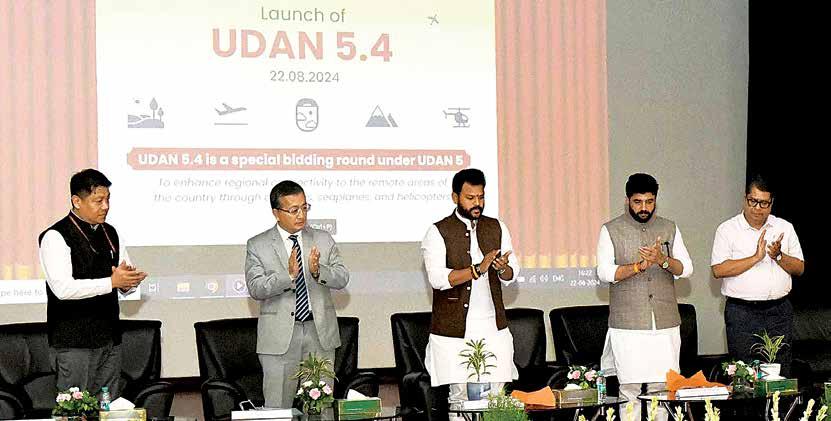
THE GOVERNMENT’S FOCUS ON INNOVATION, INCLUDING EXPLORING ELECTRIC SEAPLANES TO ALIGN WITH CLIMATE GOALS, REINFORCES ITS COMMITMENT TO FOSTERING A SUSTAINABLE SEAPLANE SECTOR
The recently launched India’s guidelines for Seaplane Operations simplify certification for non-scheduled entities to operate under the UDAN scheme, eliminating the need for a water drome license and reducing compliance requirements for easier seaplane operations
By AYUSHEE CHAUDHARY
In a significant move aimed at bolstering regional connectivity and unlocking new opportunities for economic growth, Union Minister for Civil Aviation, Kinjarapu Rammohan Naidu, recently launched India’s Guidelines for Seaplane Operations in New Delhi. Speaking at the Indian Aviation Academy, the Minister underscored the transformative potential of
seaplanes in India’s aviation landscape, highlighting their role in creating jobs and fostering inclusive development.
“These guidelines not only integrate seaplane operations into India’s aviation network but also symbolise the country’s growth, innovation, and commitment to inclusive development,” said Naidu. He emphasised that seaplanes, by connecting

remote areas, are poised to become a critical component of India’s vision for a more connected and equitable nation.
Seaplane routes have been awarded to Selected Airline Operators (SAOs) in different States/ UTs under RCS-UDAN scheme. To conduct scheduled flights under RCS-UDAN, it is mandatory as per the requirement for operators to operate flights either under Scheduled Operator or Scheduled Commuter Operator (SCO) permit and such flights could be undertaken only from licensed water aerodromes. “The SAO shall operate multi/single engine seaplanes, duly certified/accepted by DGCA in accordance with the Type Certificate issued by FAA/EASA or other authorities acceptable to DGCA and under conditions, if any, as stipulated by DGCA,” the guidelines state.
The new guidelines for seaplane operations introduce a simplified certification process, allowing non-scheduled entities to operate under the regional air connectivity scheme, UDAN. The relaxed norms by the Directorate General of Civil Aviation (DGCA) eliminate the need for a water drome license and reduce compliance requirements, facilitating easier takeoffs and landings on water.
Additionally, fresh Commercial Pilot License (CPL) holders can now directly obtain seaplane ratings, enabling them to operate these aircraft. These guidelines prioritise safety and efficiency while clarifying the responsibilities of all stakeholders. The adoption of the Non-Scheduled Operator Permit (NSOP) framework for seaplanes marks a key step in the government’s effort to boost regional connectivity. In June, the DGCA revised infrastructure procedures and pilot training requirements to further streamline seaplane operations, making it easier to reach remote areas.
In addition to unveiling the seaplane guidelines, Minister Naidu also launched the latest version of the UDAN (Ude Desh Ka Aam Nagrik) scheme—UDAN 5.4. Under this iteration, fresh bids will be invited to reopen unserved routes that were previously canceled. This is a part of India’s ongoing efforts to enhance regional connectivity under the Regional Connectivity Scheme (RCS).
As a testament to India’s commitment to advancing seaplane operations, the Minister also announced upcoming demonstration flights of seaplanes manufactured by DeHavilland, a prominent aircraft manufacturer.
The Minister’s focus on India’s unique geographical features played a key role in shaping the seaplane guidelines. “With a 7,517 km long coastline and an extensive network of rivers and lakes, India has a tremendous opportunity for the development of seaplane operations,” said Naidu. He pointed out that the Government’s experience with helicopter operations under the RCS scheme had informed a flexible, pragmatic approach to the development of seaplane infrastructure.
The newly launched Seaplane Non-Scheduled Operator Permit (NSOP) Guidelines provide a detailed framework for integrating seaplane operations into India’s aviation ecosystem. By extending the Viability Gap Funding (VGF) under RCS to seaplanes, the Government aims to provide a critical initial boost for operators, ensuring their economic sustainability.
“While promoting seaplane operations, we have taken due care to ensure safety and security,” the Minister emphasised. He explained that despite challenges, particularly in developing
water aerodromes, the Government is committed to supporting seaplane growth. Drawing on the success of NSOP operations for helicopters and small aircraft, the guidelines prioritise a safe and seamless approach to seaplane operations across the country.
The adoption of the NSOP framework for seaplanes, similar to its success in helicopters, is a major step forward in India’s efforts to enhance regional connectivity. The guidelines define clear roles and responsibilities for all stakeholders, from operators to regulatory bodies, ensuring that the industry operates efficiently and safely.
During his address, Minister Naidu stressed the need for a policy environment that supports innovation in the seaplane sector. “We must encourage research into technologies like electric seaplanes to reduce carbon emissions, aligning with India’s climate commitments under the UN Framework on Climate Change,” he stated. The Minister also highlighted the Government’s focus on local workforce development, aiming to create jobs for pilots, maintenance staff, and ground crews.
“Our goal is to foster a regulatory framework that promotes growth and innovation while generating employment. We envision developing Multimodal Transport Hubs for seamless connectivity between seaplanes and other forms of transport,” said Naidu. This vision signals the potential for seaplanes to become an integral part of India’s future transportation ecosystem, improving not only connectivity but also tourism and trade.
Union Minister of State for Civil Aviation, Murlidhar Mohol, added that this initiative would not only improve connectivity but also boost tourism and economic growth in remote areas.
economic challenges and the impact of the COVID-19 pandemic. Similar initiatives were planned under the Centre’s UDAN scheme to introduce seaplane connectivity across lakes, dams, inland waterways, and coastal areas. One notable seaplane service saw Prime Minister Narendra Modi flying from the Sabarmati riverfront to the Statue of Unity. However, the service, operated by SpiceJet, was discontinued due to pandemicrelated economic difficulties. However, Naidu is optimistic about the potential for growth under the new guidelines, which have been designed with flexibility and scalability in mind.
Union Civil Aviation Secretary, Vumlunmang Vualnam, reinforced the Ministry’s proactive approach to fostering the seaplane sector. “We have decided to leverage the NSOP framework, which has already proven successful for helicopters and small aircraft under the RCS scheme. The Seaplane NSOP Guidelines will provide a structured and safe framework for seaplane operations, even as we work towards the full development of water aerodrome infrastructure,” said Vualnam.

“These guidelines not only integrate seaplane operations into India’s aviation network but also symbolise the country’s growth, innovation, and commitment to inclusive development”
— Kinjarapu Rammohan Naidu, Union Minister for Civil Aviation
“The newly launched guidelines are designed to ensure that seaplane operations are conducted safely and efficiently, marking a new era in India’s aviation landscape,” he said.
The focus on seaplanes is expected to breathe new life into India’s tourism industry by opening up some of the country’s most remote and inaccessible regions. With the proper infrastructure and regulatory framework in place, seaplanes are set to play a key role in connecting these areas to larger economic hubs, facilitating trade, tourism, and regional development.
However, Seaplane operations in India are not without challenges. Earlier government efforts to connect 10 waterdromes across the country under the regional connectivity scheme had limited success. Attempts to launch seaplane services in states like Gujarat and the Andaman Islands faced setbacks due to
Several companies, including SpiceJet, Maritime Energy Heli Air Services Private Ltd (Mehair), and Heritage Aviation, have reportedly expressed interest in entering India’s seaplane sector. International manufacturers like De Havilland Aircraft and Cessna are also expected to explore opportunities in this space. Currently, seaplanes imported for non-scheduled operator permit (NSOP) operations are subject to a duty of less than five per cent. State governments such as Maharashtra, Gujarat, and Andhra Pradesh are eager to establish seaplane connectivity, particularly for coastal and island regions. Sources noted, “Island chains stand to benefit greatly from dedicated seaplane operations.” However, while the sector’s potential is recognised, current aviation guidelines, designed for major airports and airlines, don’t fully address the unique needs of seaplane operators.
However, this guidelines come bearing a ray of positivity. The event, held at the Indian Aviation Academy, saw participation from key stakeholders, including the Director General of Civil Aviation, Vikram Dev Dutt, senior officials from the Ministry of Civil Aviation, representatives from State and Union Territory Governments, NSOP operators and seaplane manufacturers.
The launch of the Seaplane Guidelines and the 5.4 version of the UDAN scheme marks a significant step forward in India’s aviation journey. With a focus on sustainability, innovation, and job creation, India is positioning itself at the forefront of regional aviation growth. By promoting seaplane operations and creating a favorable environment for their success, the Government is unlocking new opportunities for connectivity, tourism, and economic empowerment, solidifying seaplanes as symbols of India’s future growth and development. SP

On just her second flight, Gladys Roy co-piloted the plane, stepped out onto its wing and leapt off, floating safely to the ground with a parachute. Then and there she knew that her heart was in daredevil stunts and wing walking.
Gladys Roy was a 1920s wing walker, barnstormer and film actress, whose aerial stage was over Minnesota and California. She became famous by performing incredible feats that would terrify most people and quickly gained a reputation as a daredevil. Among the spectacular stunts she executed on the wing of a plane in flight was walking blindfold from wingtip to wingtip and dancing the Charleston. However, what really caught the attention of people worldwide was an airborne tennis match she played with another woman. She also made a parachute jump from 17,000 feet and one from just 100 feet, sustaining severe injuries in the process. The latter feat made her the unratified world record holder for the lowest parachute jump.
Gladys Roy was born in Minneapolis, Minnesota. According to her tombstone she was born in 1896. Other sources put the date later – anything up to 1904. Quite likely she wished to appear younger than she was to impress the crowds and appeal to Hollywood. Three of her brothers were pilots with Northwest Airlines. In 1921 Gladys experienced her first joyride. A week later, on just her second flight, she co-piloted the plane, stepped out onto its wing and leapt off, floating safely to the ground with a parachute. Then and there she knew that her heart was in daredevil stunts and wing walking.
Wing walking actually began as a practical necessity as early as 1911. Pilots would sometimes need to get onto their plane’s wings to make minor in-flight repairs or other small adjustments. Pretty soon some intrepid pilots realised that they could draw the crowds and rake in big bucks by demonstrating death-defying aerial stunts on the wing. Most wing walking was undertaken on the ubiquitous biplanes that were built by the thousand during the First World War, and later found their way to the civilian market. There was no dearth of ex-military personnel qualified to fly them. The most popular machine for the sport was the Curtiss JN-4 “Jenny”. Sometimes wing walkers were attached by safety wires, or wore parachutes, but quite often not. A slight misstep could send them plunging to their death. Many young women joined in enthusiastically. If they could not vote, they could at least walk, dance and do other crazy stuff on the wings of planes! Gladys Roy, with her film actress looks, was in great demand. She appeared in the 1925 film, “The Fighting Ranger”, but was seriously injured when her horse threw her off its back during
production. Unfortunately, this was not the only serious accident she experienced.
Gladys performed at fairs, auctions, and real estate exhibitions, and the crowds just loved her antics. The event that made her famous worldwide occurred in 1925 over Los Angeles. Gladys and another woman wing walker, Ivan Unger, strapped themselves to the wings of a biplane. The plane took off and levelled out just 300 m above the busy streets of Los Angeles. The two women suddenly stood up holding tennis racquets, and facing each other, on opposite sides of a net that had been fixed to the centre of the plane’s wing. Another aircraft flying nearby took a picture of the two make-believe tennis players in mid-air, with Gladys facing the camera ready for an imaginary serve. The iconic photograph went viral practically overnight, long before the advent of social media.
Considering how Gladys risked death practically every time she got airborne, the end came in a strange way. She had been earning $200 to $500 per performance in 1924, and was in great demand, being perfectly brilliant at inventing new and more thrilling routines. However, inevitably, the law of diminishing returns set in, and by 1926 her earnings had fallen to just $100 a performance. In a May 1926 interview with the Los Angeles Times, she said ruefully, “Of late the crowds are beginning to tire of even my most difficult stunts and so I must necessarily invent new ones, that is, I want to hold my reputation as a daredevil. Eventually an accident will occur...” Her words turned out to be sadly prophetic.
In late 1927, Gladys Roy was scheduled to participate in a flight from New York to Rome as co-pilot. On August 15, 1927, in an effort to remain in the spotlight, she arranged to be photographed with “Miss Ohio,” Evelyn Wilgus, The photoshoot was almost over when Gladys started the engine of her plane and alighted from the wing. Then, according to an Associated Press report, she “unconsciously walked into the propeller.” She was immediately rushed to hospital, but the heavy blade had torn deep into her skull and she died hours later. Her tragic and untimely demise was a stark reminder of the grave risks the early aviators faced, even as they captivated the imagination of people everywhere. SP
— JOSEPH NORONHA
PRIME MINISTER INAUGURATES AIRCRAFT COMPLEX FOR MANUFACTURING OF C295 AIRCRAFT

Prime Minister Narendra Modi and his Spanish counterpart Pedro Sanchez jointly inaugurated the TATA Aircraft Complex for manufacturing of C295 aircraft at TATA Advanced Systems Limited (TASL) Campus in Vadodara, Gujarat on October 28, 2024.
Addressing the gathering, the Prime Minister remarked that it is Pedro Sanchez’s first visit to India and the partnership between the two countries is finding a new direction today. Noting the inauguration of the TATA Aircraft Complex for manufacturing C295 aircraft, the Prime Minister said that it would not only strengthen the relations between the two nations, but also give momentum to the mission of ‘Make in India, Make for the World’. Modi conveyed his best wishes to the entire team of Airbus and TATA on the occasion. Recalling the foundation stone laying of the factory in October 2022, the Prime Minister said that the facility is now ready for production of C295 aircraft.
SWEDEN SELECTS THE EMBRAER C-390 MILLENNIUM

The Swedish Ministry of Defense announced the selection of the Embraer C-390 Millennium as Sweden’s new tactical transport aircraft. This strategic decision from another North Atlantic Treaty Organization (NATO) member country marks the first acquisition of the C-390 in Northern Europe, underscoring Sweden’s

Air Marshal S.P. Dharkar assumed charge as Vice Chief of Air Staff at Air HQ. Commissioned in the fighter stream in 1985, he’s an alumnus of RIMC, NDA, Defence Services Staff College and US Air War College. He has commanded a frontline fighter unit, served as the first DG of Defence Space Agency and was Air Officer Commanding in Chief of EAC prior to taking over as VCAS.

Air Marshal Ajay Kumar Arora assumed the appointment of Air Officer-in-Charge Maintenance, Indian Air Force. He was commissioned in the Aeronautical Engineering stream of IAF in August 1986. He is a graduate of Air Force Technical College, Air Command and Staff College, USA and College of Defence Management, Secunderabad. An electronics and communication engineer by qualification, he is also an alumnus of lIT Kharagpur and a Doctorate degree holder in Management from University of Pune. He has held key command and staff appointments in his illustrious career of 38 years. He was the Director General (Aircraft) before assuming the appointment of Air Officerin-charge Maintenance.

AIR MARSHAL ASHUTOSH DIXIT
Air Marshal Ashutosh Dixit assumed the appointment of Air Officer Commanding-in-Chief of Central Air Command on September 1, 2024. He was commissioned into the fighter stream of IAF on December 06, 1986. Before taking over as the Air Officer Commanding-in-Chief of Central Air Command, he was tenanting the appointment of Deputy Chief of the Air Staff.

Air Marshal Surat Singh assumed charge as the Air Officer Commanding-in-Chief, Eastern Air Command, IAF, on October 1, 2024. An alumnus of NDA, he was commissioned in the fighter stream in December 1986. He has commanded a frontline Air Force Station, and has held various key appointments before taking over as AOC-in-C, EAC.

Air Marshal Awadhesh Kumar Bharti assumed the position of Director General Air Operations. Commissioned into the fighter stream in 1987, he is an alumnus of NDA, Defence Services Staff College, Wellington, and the National Defence College. Prior to his current role, he held several key appointments, including Air Officer Commanding Advance HQ EAC, Assistant Chief of Air Staff Operations (Offensive), and Senior Air Staff Officer of CAC.
commitment to enhancing its defence capabilities with state-of-the-art aircraft. Embraer already has a long-term partnership with Sweden, which will be further deepened with the C-390 selection.
The C-390’s selection aligns with a growing trend among European NATO member countries recognising the aircraft’s effectiveness in addressing both current and future defence needs.
Sweden is the sixth European nation to select the aircraft, along with Austria, Czech Republic, Hungary, Netherlands and Portugal. Sweden’s acquisition of the C-390 will not only bolster national defence, but also enhance interoperability with allied forces while benefiting from the synergies present in Europe in terms of training facilities, support and logistics.
GA-ASI AND BAE SYSTEMS COLLABORATE ON MQ-20 AVENGER
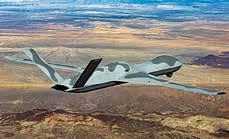
General Atomics collaborated with BAE Systems to demonstrate unique electronic warfare (EW) capabilities remotely controlled via a secure, jam-resistant Link 16 network on an MQ-20 Avenger® unmanned aircraft system (UAS). The Avenger is a jet-powered platform used extensively as a test bed for autonomous UAS development and the Collaborative Combat Aircraft (CCA) programme. The demonstration helps accelerate emerging networked electronic attack capabilities for US Air Force Autonomous Collaborative Platforms (ACPs) and is part of an ongoing series of technology insertion and autonomous flights performed using internal research and development funding to prove important concepts.
DEFENCE MINISTER RAJNATH SINGH PRESIDES OVER MAIDEN JOINT COMMANDERS’ CONFERENCE

Defence Minister Rajnath Singh presided over the maiden Joint Commanders’ Conference on September 5, 2024. In line with the theme of the conference, ‘Sashakt aur Surakshit Bharat: Transforming the Armed Forces’, Rajnath Singh stated that India is a peace loving
nation and the Armed Forces need to be prepared for war in order to preserve peace. He stressed upon the significance of evolving joint military vision and preparing for the type of challenges the country may face in future wars, while emphasising on synergised, swift and proportionate response to provocations.
Referring to the ongoing RussiaUkraine & Israel-Hamas conflicts and the current situation in Bangladesh, the Defence Minister exhorted the Commanders to analyse these episodes, predict the problems that the country may face in the future, and stay prepared to deal with the “unexpected”. He emphasised on the need of a broader & deeper analysis by the top military leadership in view of the situation along the Northern border and the happenings in neighbouring countries, which are posing a challenge to peace & stability in the region.
In a major boost to Atmanirbhar Bharat, Ministry of Defence (MoD) has signed a contract with Hindustan Aeronautics Limited (HAL) for 240 AL-31FP Aero Engines for Su-30 MKI aircraft at a cost of over `26,000 crore. These aeroengines will be manufactured by the Koraput Division of HAL and are expected to fulfil the need of the Indian Air Force to sustain the operational capability of the Su-30 fleet for the defence preparedness of the country. HAL would supply 30 aero-engines per annum as per the contractual delivery schedule. The supply of all 240 engines would be completed over the period of next eight years.
The first of eight Boeing AH-6 Little Bird light attack helicopters for the Royal Thai Army completed a successful first flight. After completing Thailand’s fleet, Boeing will train the Royal Thai Army pilots at its Mesa site and at US Army Yuma Proving Ground, where they will learn to operate the Little Bird and leverage its versatile mission capabilities. The Royal Thai Army has procured the AH-6 as part of its ongoing efforts to enhance aviation readiness and modernise national defence capabilities.
Featuring a purpose-built military fuselage, integrated cockpit, and the latest fully integrated weapons, the AH-6 was designed for a wide range of missions and operating environments to meet customers’ needs around the world.

Embraer is proud to announce the spotlight appearance of its C-390 Millennium multi-mission military transport aircraft. Embraer presented all the capabilities of the C-390 Millennium to the President of South Africa, Matamela Cyril Ramaphosa and the Minister of Defense Angie Motshekga. This new generation aircraft also attracted great interest from the South African National Defence Force (SANDF), which had the opportunity to evaluate it.
“Embraer recognises the professionalism and dedication of the SANDF during the ongoing selection process to renew its fleet of legacy transport aircraft as the C-390 is a strategically important aircraft that offers outstanding versatility, range, and speed. We are confident that it is well suited to meet the needs of the South African National Defense Force as well as other government authorities”, said Bosco da Costa Junior, President and CEO, Embraer Defense & Security.

SpiceJet has announced plans to launch seaplane operations in 2025, connecting some of India’s most remote and picturesque locations. The announcement was made by SpiceJet’s Chairman and Managing Director, Ajay Singh, on the occasion of a demonstration seaplane flight from Prakasam Barrage in Vijayawada to Srisailam Dam, attended by Chief Minister of Andhra Pradesh. N. Chandrababu Naidu and Union Minister of Civil Aviation, K. Rammohan Naidu.
SpiceJet has partnered in seaplane trials across multiple locations, providing crucial engineering, technical, and logistical support to De Havilland. With rights to operate seaplane services on 20 routes, including Lakshadweep, Hyderabad, Guwahati, and Shillong, the airline is preparing to roll out connectivity across key routes as the infrastructure becomes ready.
SpiceJet pioneered India’s first scheduled seaplane service in October 2020, linking the Sabarmati Riverfront in Ahmedabad to the Statue of Unity in Kevadia, Gujarat. Although paused due to COVID-19, the airline is once again ready to spearhead this ambitious project.
Pratt & Whitney Canada will demonstrate hydrogen combustion technology on a PW127XT regional turboprop engine as part of a project supported by Canada’s Initiative for Sustainable Aviation Technology (INSAT). The project, named Hydrogen Advanced Design Engine Study (HyADES), will be in collaboration with Next Hydrogen Solutions Inc., which will develop high-efficiency, lowcost electrolyzers needed for establishing hydrogen production infrastructure.
Funding for the first phase of the project will include fuel nozzle and combustor rig testing using hydrogen fuel, while future phases will target full engine ground testing. The PW127XT engine is the most advanced member of Pratt & Whitney Canada’s PW100 engine series, which has powered regional turboprop aircraft for forty years and accumulated more than 220 million flight hours.

Boeing and Emirates SkyCargo announced an order for five more of the world’s largest and longest-range twinengine freighter, building on its earlier purchase of five 777 Freighters. The latest order, which was finalised in September and listed as unidentified on Boeing’s Orders and Deliveries website, brings Emir-
ates’ order book to 249 Boeing widebody airplanes, including 14 777 Freighters. As the cargo division of the world’s largest international airline, Emirates SkyCargo plans to operate 21 777 Freighters in the coming years — nearly doubling its current fleet of 11 freighters as the carrier continues to expand capacity. The 777 Freighter can fly farther (9,200 kilometers / 4,970 nautical miles) and carry more freight (102 tonnes) than any other twin-engine cargo jet today. This capability enables operators to fly more freight on more nonstop routes with better operating economics, connecting high-value cargo markets such as the Middle East with the US and Europe.
Boeing India Engineering & Technology Center (BIETC) leaders and employees inaugurated Building 2 (B2) of the BIETC campus in Devanahalli, Bengaluru. The B2 section of the campus will feature advanced Boeing Research & Technology and Boeing Test and Evaluation laboratories, collaborative workspaces, a medical center, and a creche facility, among others.
In January 2024, Prime Minister Modi inaugurated this state-of-the-art 43-acre campus. Built with an investment of `1,600 crore, this is Boeing’s largest such investment outside the US It includes two buildings, B1, and B2, and accommodates Boeing India’s engineering and technology workforce. Through this campus, Boeing aims to enhance engineering and technology capabilities to support advanced aerospace and defense work in India and around the world.
MTU Aero Engines has reached an important milestone on its path to zero-emission flight—it successfully completed multi-week testing of a liquid hydrogen fuel system for its Flying Fuel Cell™ (FFC). Together with MT Aerospace AG, the engine specialist is developing a complete liquid-hydrogen fuel system for commercial aviation that consists of tanks, sensors, heat exchangers, valves, safety systems, and controls. MT Aerospace is responsible for the liquid hydrogen tank and successfully tested the first system at its headquarters in Augsburg. Now MTU is following suit—these results are important and special because the tests were done with liquid hydrogen, which is the actual operating medium for the FFC.
Embraer announced the expansion of its maintenance, repair and overhaul (MRO) services network to support the growing fleet of E-Jets in the Unites States by opening a new Embraer owned service centre in Fort Worth, Texas.
Embraer expects to begin operations in an existing hangar, in the first quarter of 2025, while building a second hangar that should be concluded by 2027. With the new facilities, Embraer’s capacity to serve the E-Jets customers is expected to have a considerable increase in the US. The new Fort Worth service center will be added to the global network of Embraer which includes 80 authorised centers and 12 owned service centers around the world. The city of Fort Worth has been selected as the finalist location for the proposed project, subject to approval by local government authorities of certain proposed incentives.
E-FREIGHTER
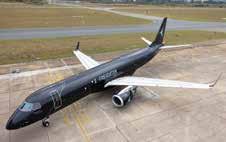
The E-Freighter, Embraer’s E190F has been fully certified by the Federal Aviation Administration (FAA). Embraer’s passenger-to-freighter conversion and the Cargo Loading System, developed by US Cargo Systems, have received the certification by FAA in September 2024. In July, the E-Freighter was certified by the National Civil Aviation Agency of Brazil (ANAC) and EASA certification is due later this year. The aircraft was developed to fill a gap in the air cargo market and to replace older, less efficient models.
The E190F programme was launched in May 2022 to meet the changing demands of e-commerce and modern trade, which require fast deliveries and decentralised operations driving the demand for faster delivery of shipments to regional markets. E-Jets converted to freighters will have over 40 per cent more volume capacity, three times the range of large cargo turboprops, and up to 30 per cent lower operating costs than larger narrowbodies. If combining capacity under the floor and main deck, the maximum structural payload is 13,500 kg for the E190F. l

Private jets play a strategic role in allowing business magnates like Ambani to optimise time management, particularly critical given his global business commitments and a packed travel schedule.
Mukesh Ambani’s acquisition of a new Boeing business jet adds a significant addition to his private aviation fleet, placing him among a select group of global business magnates. Boeing Business Jets (BBJs) are renowned for their unique blend of commercial aircraft performance with luxurious customisations to suit high-profile clients like Ambani.
Though specific details about the exact model and configurations of Ambani’s new BBJ remain confidential, these jets generally offer expansive cabin space and adaptability. Configurations often include master suites, private offices, lounges, and advanced communication facilities, allowing Ambani to conduct business in flight seamlessly. These jets are also equipped with state-of-the-art technology to ensure connectivity even on international routes, enabling executives to stay productive regardless of time zone differences.
Mukesh Ambani is no stranger to private aviation. His fleet reportedly includes several high-end jets, including Falcon and Gulfstream. Each jet in his collection serves unique purposes. The larger jets, such as the BBJ series, are suited for long-haul international travel, allowing Ambani to oversee Reliance’s diverse interests across the globe. In contrast, the smaller jets may serve shorter or domestic routes.
Ambani’s jet acquisition is part of a growing trend among UHNWIs in India, who increasingly rely on private jets to enhance productivity and privacy. For business tycoons, the need to juggle multiple international locations requires flexibility that commercial flights cannot always provide. Private jets allow UHNWIs to schedule flights at their convenience, avoid crowded terminals, and carry out confidential business discussions securely.
In India, the private jet market has expanded rapidly in recent years, with demand driven by high-profile industrialists and Bollywood celebrities. This trend is expected to grow, given India's projected economic expansion and the rising number of ultra-high-net-worth individuals. Ambani’s purchase highlights the growing private jet market in India, which continues to develop despite the economic challenges faced by the aviation sector globally. India's private jet industry benefits from an increasing number of HNIs and UHNWIs who view these jets as essential business tools rather than mere luxury items.
By ROHIT GOEL
Ambani, as one of the most influential business figures in India, has long served as a trendsetter in lifestyle and business practices. His decisions, including the choice to expand his fleet, often influence trends among India’s elite. His investment in a new BBJ can be seen as an endorsement of private aviation’s role in executive travel, possibly encouraging more high-networth individuals to consider similar purchases.
Business Jets are built with flexibility to meet the demands of high-profile clients, allowing them to customise the interiors to suit personal and professional needs. These jets typically feature layouts that can support full conference rooms, private suites, and ultra-luxurious lounges. Ambani’s business jet likely incorporates these customisations to enable a seamless transition from his office environment to his in-flight workspace.
For a billionaire of Mukesh Ambani’s stature, a new private jet is not simply a mode of transportation but a symbol of influence, mobility, and success. In a country where Reliance’s impact on the economy is substantial, every major purchase by Ambani often attracts significant public and media attention. While for many, a jet purchase signals luxury, it also underscores Ambani’s business-driven lifestyle, wherein travel efficiency is crucial.
There’s also an element of prestige in owning a Boeing Business Jet, a brand associated with reliability and elegance. This purchase may stir conversation about the luxury consumption habits of India’s wealthiest, especially against a backdrop of wealth inequality. However, Ambani’s growing fleet can be seen as an investment in business efficiency, emphasising the need for speed and flexibility in overseeing Reliance’s global reach.
The expanding fleet of business jets in the stable of Mukesh Ambani is because he needs them to maintain optimal travel flexibility, a necessity for managing a vast, multinational conglomerate. It is also a reflection of the booming private aviation sector in India, fuelled by an increasing demand. As UHNIs continue to expand their fleet, it reinforces the role of private jets as essential tools in executive mobility for business productivity. Government of India must notice this broader rise in demand for high-end aviation solutions among India’s wealthiest and do its utmost to support this market on the rise amidst a rapidly growing economy. SP




